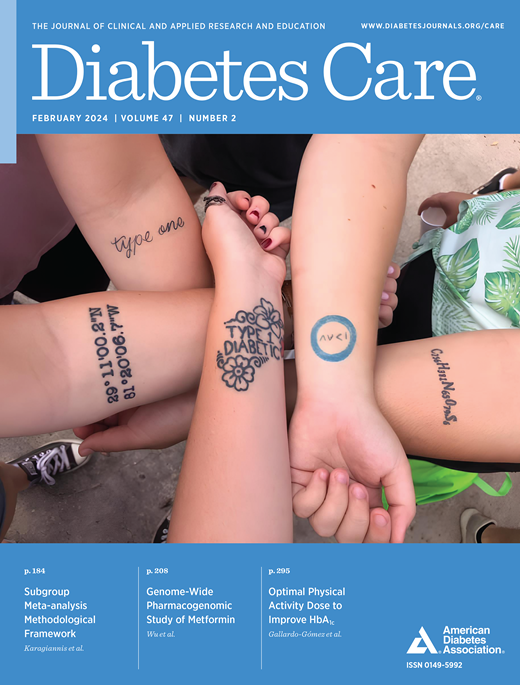妊娠中期筛查妊娠糖尿病对妊娠结局的影响:TESGO随机对照试验
IF 16.6
1区 医学
Q1 ENDOCRINOLOGY & METABOLISM
引用次数: 0
摘要
目的:妊娠期糖尿病(GDM)妇女分娩的新生儿比目前推荐的筛查期更早加速宫内生长。我们的目的是确定与妊娠24-28周的标准筛查相比,妊娠18-20周使用单一口服葡萄糖耐受不良试验(OGTT)进行GDM筛查是否能改善妊娠结局。研究设计和方法我们在单胎妊娠妇女中进行了一项双中心、平行、随机对照试验,并计划进行中期分析,比较妊娠中期筛查妊娠18-20周GDM和标准筛查妊娠24-28周GDM的效果。使用75克ogtt和国际糖尿病和妊娠研究小组协会的标准对GDM进行普遍筛查和诊断。主要结局是一次剖宫产、出生体重的综合指标。第90百分位,新生儿低血糖,脐带血清c肽;90百分位,妊娠期高血压,先兆子痫,和出生创伤。结果中期分析后因无效而提前终止试验。在纳入意向治疗分析的967名妇女中,两组间的主要结局无显著差异。与标准筛查组相比,妊娠中期筛查组GDM妇女的新生儿低血糖率明显降低,新生儿肥胖率较高。两组不良事件发生率相似。结论:在妊娠中期(妊娠18-20周)推进通用GDM筛查可能不会改善妊娠结局,除了降低新生儿低血糖。通过妊娠中期筛查诊断为GDM的妇女的新生儿有较高的新生儿肥胖。本文章由计算机程序翻译,如有差异,请以英文原文为准。
The Effect of Midpregnancy Screening for Gestational Diabetes Mellitus on Pregnancy Outcomes: The TESGO Randomized Controlled Trial
OBJECTIVE Newborns delivered by women with gestational diabetes mellitus (GDM) have accelerated intrauterine growth earlier than the current recommended screening period. We aimed to determine whether universal GDM screening using a single oral glucose intolerance test (OGTT) at 18–20 weeks’ gestation improves pregnancy outcomes compared with standard screening at 24–28 weeks’ gestation. RESEARCH DESIGN AND METHODS We conducted a dual-center, parallel, randomized controlled trial with a planned interim analysis in singleton pregnant women to compare the effect of midpregnancy screening for GDM at 18–20 weeks’ gestation and standard screening at 24–28 weeks’ gestation. GDM was universally screened and diagnosed using 75-g OGTTs and the International Association of the Diabetes and Pregnancy Study Groups criteria. The primary outcome was a composite measure of primary cesarean delivery, birth weight >90th percentile, neonatal hypoglycemia, cord serum C-peptide >90th percentile, gestational hypertension, preeclampsia, and birth trauma. RESULTS The trial was stopped early for futility after the interim analysis. Of the 967 women included in the intention-to-treat analysis, the primary outcome was not significantly different between the two groups. Neonatal hypoglycemia was significantly lower and neonatal adiposity in women with GDM was higher in the midpregnancy screening group compared with the standard screening group. Adverse event rates were similar between the two groups. CONCLUSIONS Advancing universal GDM screening to midpregnancy at 18–20 weeks’ gestation may not improve pregnancy outcomes, except for a reduction in neonatal hypoglycemia. Newborns of women diagnosed with GDM through midpregnancy screening had higher neonatal adiposity.
求助全文
通过发布文献求助,成功后即可免费获取论文全文。
去求助
来源期刊

Diabetes Care
医学-内分泌学与代谢
CiteScore
27.80
自引率
4.90%
发文量
449
审稿时长
1 months
期刊介绍:
The journal's overarching mission can be captured by the simple word "Care," reflecting its commitment to enhancing patient well-being. Diabetes Care aims to support better patient care by addressing the comprehensive needs of healthcare professionals dedicated to managing diabetes.
Diabetes Care serves as a valuable resource for healthcare practitioners, aiming to advance knowledge, foster research, and improve diabetes management. The journal publishes original research across various categories, including Clinical Care, Education, Nutrition, Psychosocial Research, Epidemiology, Health Services Research, Emerging Treatments and Technologies, Pathophysiology, Complications, and Cardiovascular and Metabolic Risk. Additionally, Diabetes Care features ADA statements, consensus reports, review articles, letters to the editor, and health/medical news, appealing to a diverse audience of physicians, researchers, psychologists, educators, and other healthcare professionals.
 求助内容:
求助内容: 应助结果提醒方式:
应助结果提醒方式:


